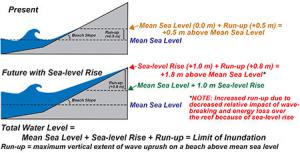Coastal resilienceCoastal uplift along Pacific Coast lower than expected, exacerbating sea-level rise impact
A new study shows that uplift rates across the Pacific Coast of the United States and northern Mexico have been overestimated by an average of more than 40 percent. These lower uplift rates this may have important implications for coastal management, including earthquake hazards and the potential impact of sea-level rise to coastlines across the Pacific Coast. If the Pacific Coast’s uplift rate is lower than had been estimated, this means that sea-level rise would have an even greater impact on coastal communities and infrastructure. Higher coastal uplift rates would have negated some of the effects of rising sea levels, something lower uplift rate will not do.

Rendering of the mechanics of Pacific coast sea-level rise // Source: usgs.gov
A new GSA Bulletin study shows that uplift rates across the Pacific Coast of the United States and northern Mexico have been overestimated by an average of more than 40 percent. The Geological Society of America (GSA) says that these lower uplift rates imply that the shorelines of the West Coast are rising at a slower rate than previously thought, and this may have important implications for coastal management, including earthquake hazards and the potential impact of sea-level rise to coastlines across the Pacific Coast.
If the Pacific Coast’s uplift rate is lower than had been estimated, this means that sea-level rise would have an even greater impact on coastal communities and infrastructure. Higher coastal uplift rates would have negated some of the effects of rising sea levels, something lower uplift rate will not do.
In their paper for GSA Bulletin, Alexander Simms and colleagues write, “Factors other than tectonics contribute to local sea-level change, and one important, yet often overlooked, contribution is the earth-ocean response to the changing distribution of surface loads of ice and water, often referred to as … glacial isostatic adjustment. Neglect of this effect, particularly along coastal sections at variable distances from the former ice sheets, such as the eastern Pacific coast from northern Mexico to the U.S.-Canada border, introduces large errors in uplift estimates.”
— Read more in A. R. Simms et al., “Marine terraces and rates of vertical tectonic motion: The importance of glacio-isostastic adjustment along the Pacific Coast of central North America,” Geological Society of America Bulletin (29 July 2015): B31299.1 (do: org/10.1130/B31299.1)
